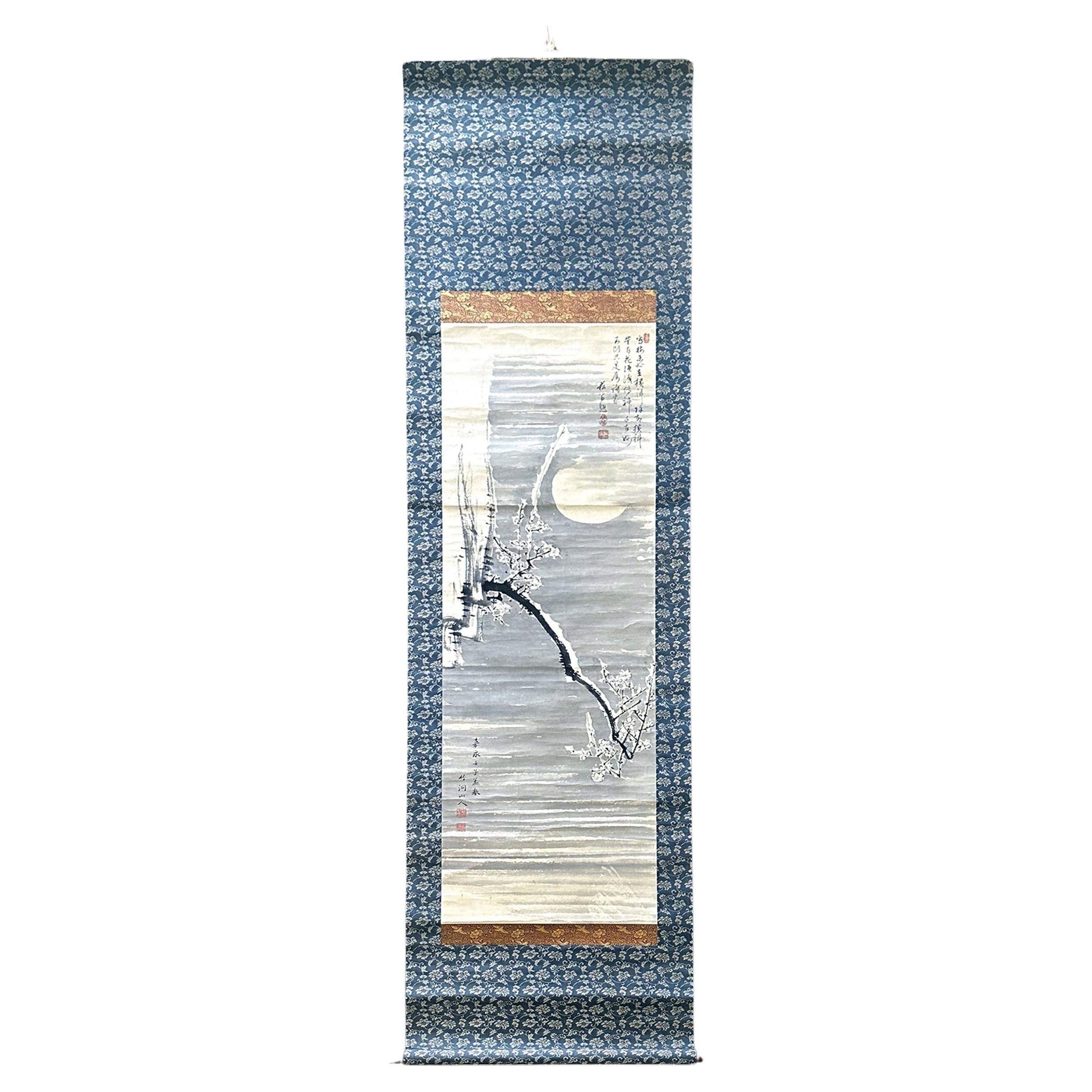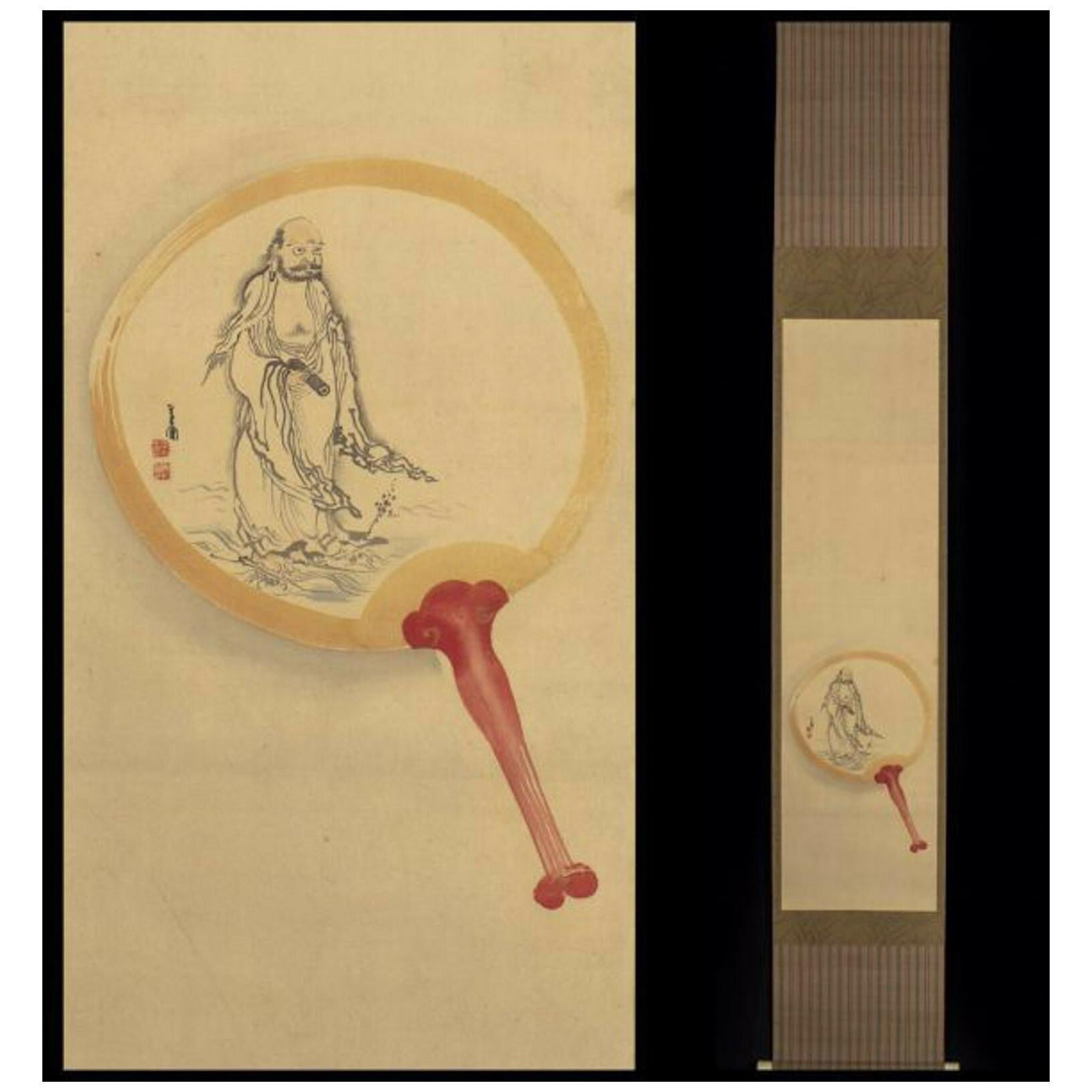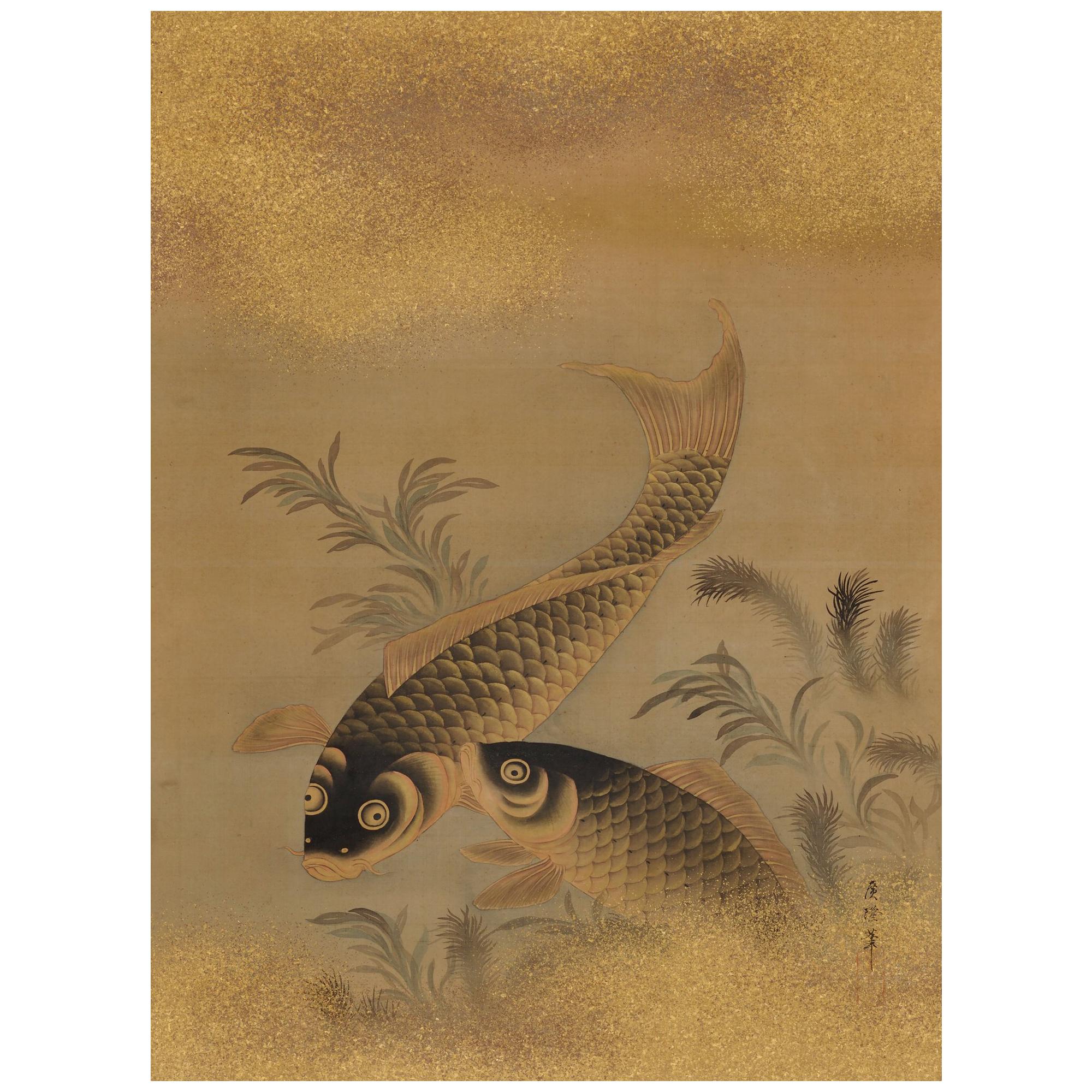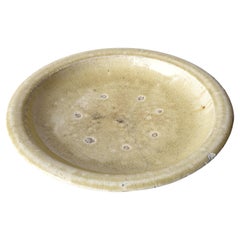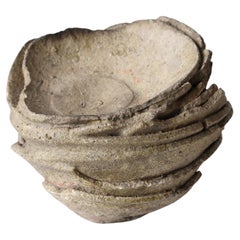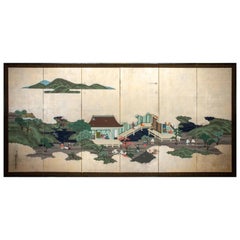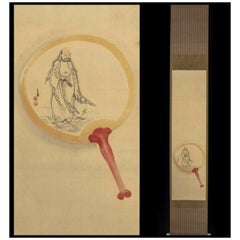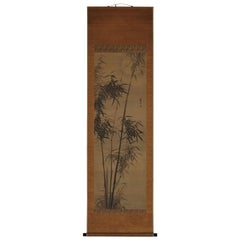Items Similar to 19th century Edo period's Hanging scroll Samurai players and child dancer
Want more images or videos?
Request additional images or videos from the seller
1 of 10
19th century Edo period's Hanging scroll Samurai players and child dancer
About the Item
Description - Hanging scroll with quite a surreal scene of the music and dance performance with two seated samurais and a child actor on a go-game-board who plays a role of dancing small puppet as a samurai’s attendant of ‘Goban-ningyo’ (lit. ‘Go-game-board doll’ / Traditional Japanese banquet performance that makes a small puppet dance on a go-game-board). Painting on paper. Edo period, 19th century, Japan (*mounted in the later years). Some damage due to age as is. Total: approx. 109 x 58cm (42.91 x 22.83in)
- Dimensions:Height: 42.91 in (109 cm)Width: 22.83 in (57.99 cm)Depth: 0.98 in (2.49 cm)
- Style:Japonisme (Of the Period)
- Materials and Techniques:
- Place of Origin:
- Period:
- Date of Manufacture:19th century
- Condition:Wear consistent with age and use.
- Seller Location:Chiba, JP
- Reference Number:1stDibs: LU9029239008702
About the Seller
No Reviews Yet
Vetted Seller
These experienced sellers undergo a comprehensive evaluation by our team of in-house experts.
1stDibs seller since 2023
- ShippingRetrieving quote...Ships From: Chiba, Japan
- Return PolicyThis item cannot be returned.
Authenticity Guarantee
In the unlikely event there’s an issue with an item’s authenticity, contact us within 1 year for a full refund. DetailsMoney-Back Guarantee
If your item is not as described, is damaged in transit, or does not arrive, contact us within 7 days for a full refund. Details24-Hour Cancellation
You have a 24-hour grace period in which to reconsider your purchase, with no questions asked.Vetted Professional Sellers
Our world-class sellers must adhere to strict standards for service and quality, maintaining the integrity of our listings.Price-Match Guarantee
If you find that a seller listed the same item for a lower price elsewhere, we’ll match it.Trusted Global Delivery
Our best-in-class carrier network provides specialized shipping options worldwide, including custom delivery.More From This Seller
View All18-19th century Japanese Edo period’s Primitive Rural Hand-Painted Map
Located in Chiba, JP
A rare find of Japanese Edo period’s (18-19th century) primitive hand-painted map with blue river flowing, encoded orange temples/shrines, and plentiful encoded rice fields and farms...
Category
Antique 19th Century Edo Paintings and Screens
Materials
Paint, Paper
Edo-Meiji 19th century Japanese mingei Seto stoneware Ishizara plate
Located in Chiba, JP
ISHIZARA PLATE – Old Japanese mingei Seto stoneware plate called ‘Ishizara’ (lit. ‘Stone plate’), Edo-Meiji period, 19th century, approx. D 33.5 x H 6cm (13.18 x 2.36in), once used a...
Category
Antique Mid-19th Century Ceramics
Materials
Ceramic
Edo-Meiji 19th century Japanese mingei Seto stoneware large Ishizara plate
Located in Chiba, JP
ISHIZARA PLATE – Old Japanese mingei Seto stoneware large plate called ‘Ishizara’ (lit. ‘Stone plate’), Edo-Meiji period, 19th century, approx. D 38 x H 6.8cm (14.96 x 2.67in), once ...
Category
Antique Mid-19th Century Ceramics
Materials
Ceramic
12-16th century Yamajawan 8-layered Japanese proto-pottery mountain bowls
Located in Chiba, JP
MOUNTAIN-CHAWAN – Supernatural unconscious object as the integrated 8-layered Japanese proto-pottery bowls (so-called ‘Yamajawan’ (Yama-Chawan / lit. ‘Mountain tea bowl’)) stuck to e...
Category
Antique 15th Century and Earlier Ceramics
Materials
Ceramic
20th century Japanese vintage modern pottery vase with two spouts
Located in Chiba, JP
DOUBLE-MOUTHED VASE – Japanese vintage modern pottery vase with two spouts, Showa period, 20th century, approx. H 23 x W 18 x D 11cm (9.05 x 7.08 x 4.33in). Unidentified potter’s car...
Category
Late 20th Century Japanese Ceramics
Materials
Ceramic
1970s-80s Japanese Vintage Modern Sosaku Kokeshi Wooden Doll
Located in Chiba, JP
Rare find of refined vintage modern kokeshi simplified wooden doll titled as ‘Hajirai’ (lit. ‘Shyness’) made by a kokeshi artist, Kenichi Murakami (1929-1991), c.1970-80s, categorize...
Category
20th Century Japonisme Sculptures and Carvings
Materials
Wood
You May Also Like
Edo period (19th century)
Located in Milano, IT
Byobu, traditional Japanese six-panel screen depicting a scene from the "Tales of Genji", with Mitsusada seal.
The scene is enclosed at the top and bottom by strips of silver leaf, ...
Category
Antique 19th Century Japanese Japonisme Paintings and Screens
Materials
Paper
Antique Japanese Ink Hanging Scroll Nakabayashi Chikuto Edo Period
By Hidaka Tetsuo
Located in Atlanta, GA
An ink painting on paper (Sumi-e) mounted with brocade borders as a hanging scroll. Entitled "Plum Blossom Under a Misty Moon", the artist was Japanese pain...
Category
Antique 19th Century Japanese Japonisme Paintings and Screens
Materials
Brocade, Wood, Paper
Lovely Japanese 18th-19th Century Edo or Meiji Scroll Painting Japan
Located in Amsterdam, Noord Holland
Maruyama–Shijo style painting
C0ndition; Good but some stains.
Overall dimensions: width of about 28.2 cm and Length of about 173.8 cm
Painting width of about 25.5 cm × leng...
Category
Antique 19th Century Japanese Meiji Paintings and Screens
Materials
Bronze
$620 Sale Price
20% Off
Japanese Painting, Hanging Scroll, 19th Century Bamboo in Moonlight
Located in Kyoto, JP
Bamboo in moonlight
Gamo Rakan (1784-1866)
Hanging scroll, ink on silk.
Dimensions:
Scroll: 201 cm x 58 cm
Image: 137 cm x 45 cm
In this early 19th century work by Gamo Rakan a light ink wash applied to the silk background silhouettes the moon and suggests the atmosphere of early evening. Even though it is a literati subject, Rakan’s bamboo is quite realistic with a strong decorative style. The painting finds its inspiration from Chinese Ming dynasty painters who often used a single-tone, jet black stroke to emphasize the calligraphic nature of bamboo.
In a different era, decorative would have been seen as somewhat unrefined. But increasingly in the Edo period, it was the hallmark of high style. The Japanese people, in particular the rising merchant class, had gradually become apathetic toward the traditional Sesshu and Kano schools of painting. Chinese professional and amateur painters living in the port of Nagasaki during the 18th century had a profound effect on Japanese painting and the freshness of their style and its decorative appeal contributed greatly to its popularity. Gamo Rakan’s teacher, Tani Buncho...
Category
Antique Early 19th Century Japanese Edo Paintings and Screens
Materials
Silk
Japanese Painting, Hanging Scroll, Mid 19th Century, Koi and Water Plants
By Iwase Hirotaka
Located in Kyoto, JP
Iwase Hirotaka (1808-1877)
Koi and Water Plants
Hanging scroll, ink, color, gold wash and gold flecks on silk
Inscription: Hirotaka
Seal: Ille...
Category
Antique 1860s Japanese Edo Paintings and Screens
Materials
Silk
Japanese Silk Scroll Painting of Moneys Edo Period Mori Tetsuzan
Located in Atlanta, GA
A Japanese mounted vertical hanging scroll painting by Mori Tetsuzan (Japanese, 1775-1841) circa 19th century Edo period. The watercolor and ink on silk ...
Category
Antique 19th Century Japanese Japonisme Paintings and Screens
Materials
Silk, Paper
Recently Viewed
View AllMore Ways To Browse
19th Century Scroll
Antique Go
Antique Two Seater
Go Game
Antique Roles
19th Century Painted Scroll
Antique Lit
Antique Player
Hanging Seat
Hanging Art Japanese
Antique Hanging Scroll
Antique Paper Scroll
Antique Paper Scrolls
Edo Period Japanese Painting
Japanese Hand Scroll
19th Century Japanese Scroll
Japanese Hanging
Traditional Japanese Painting


